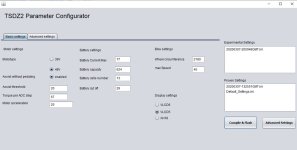eyebyesickle said:
I am quite interested in this. The only way I can see the gear sensor working when hooked to a speed sensor port, is if it makes a temporary spike in the speed sensor pickup, tricking the system to thinking that it went over the speed limit and causing a temporary cutout... Is that what you accomplished? If so, does it affect the odometer just slightly I would suspect? I'd be interested to hear any more info... This is definitely new to me...
Thank you for your interest for this potential improvement. I am sure that it has to be confirmed by other people here.
As I first bought a Bafang and discovered (I am stupid in some way) that my coast brake did not work any more, I spent another 315 € to buy a coaster brake TSDZ2, with an XH18 LCD, much smaller, more effective to change PAS, than the central Bafang C965 (sorry to say that but I don't need a temperature sensor and a large LCD because the motor is supposed to work and stop before burning, as for the battery). But, as explained on my first
video, I bought simultaneously the BBS01 motor, battery and gear sensor at the same place (and I got a 30% return on the total, from the Ville de Paris which is promoting pedelecs in central Paris). Therefore, I installed the gear sensor at that time (and at the very end of the shift cable, close to gear hub).
The gear sensor was mandatory for me because I had read on a German forum that it was mandatory to not damage the chain and the gear hub. And they were right, it was much more comfortable and secure with this gear sensor installed.
Also, as already said, recent BBS have a new gear sensor output cable, of an adequate length, in order to be plugged strait away to the Bafang 3 pin connector of the gear sensor.
When installing the TSDZ2 with its native stock firmware, I let the gear sensor in place but unconnected because I did not know how to connect, and if was possible to connect it. While installing the first motor, the Bafang, I kept the lights circuit in place with its original front hub dynamo; therefore the second connector of the Tongsheng speed sensor was free (free for installing the Bafang gear sensor with an adhoc cable...).
Fortunately, with the stock TSDZ2 firmware, it was not necessary to have a gear sensor connected. I was very doubtful, expressed my doubts on a different
forum, but after some kilometers I was convinced.
And then came the Open Source firmware story because I had read that the TSDZ2 controller could be modified in order to control the motor in the same way as the Bafang and even as the Bosch! And it is true that I really appreciated the Bafang and was a little disappointed by the TSDZ2 which made me to tired after my 25 km in central Paris every day.
I really appreciate the Open Source firmware which behaves as good as the Bafang. I have had some difficulties to understand who did what, tried to reconstruct the paternity up to Stancecoke who maintained probably the most useful github fork of Casainho, Marcoq, Mbrusa etc works (I forked the Stancecoke fork in order to adapt the Java configurator to OS/X and Linux too).
Sorry for this long story and I will try to respond to eyebyesickle
- As said by ilu, "apparently the gear shift sensor works as the HWB sensor". Thus here is again the wiring
- Tongsheng 6 pin male <=> Bafang 3 pin female (Higo 3 type B, orange connector)
- 1 orange ground; <=> 8 black ground;
- 2 white (speed sensor). 5V or nothing; <=> 4 blue (brake signal or speed sensor or gear shift sensor);
- 4 green (+ 5V for light) <=> 6 red 5V;
thus the 1(=8= Ground) and the 4(=6=+5V) are easy. The hidden wire brake sensor needs this 5V and, when used, connects the pin 2(=4) to the ground 1(=8), during 2 seconds (as Rydon said if I understood him correctly).
(New Edit: +5V is on position 4 for Tongsheng, TSDZ2 wires are described for example here and Bafang there)
Here, with the gear sensor it is exactly the same process but it lasts as Rydon said 800ms only.
Now, when hooked to the speed sensor what happens? As said earlier, I think that the 800ms cutoff is adding a parasite signal to the speed sensor signal. And, apparently and fortunately, the controller is able to manage this erratic signal correctly.
For me it behaves as if you take a second magnet and approaches it randomly in front of the speed sensor head while the wheel is turning at a regular speed. How does the firmwares (and which part of if, Program, EEPROM?) react, that is the question?
- Apparently, and according to my short experience it behaves well and the controller is not affected at all by the gear sensor signal.
- At all?, well my first concern was to verify that the 25 km/h upper legal speed was not affected by this gear sensor and I can say that it is not.
- eyebyesickle: does it affect the odometer just slightly I would suspect? . Yesterday while biking close to a colleague I asked to verify the speed meter, it was 23km/h for both of them. Odometer I have to try with exactly the same path to work. It will be very close, I am sure, even if I shift gear speed every 20 seconds or so.
Regards,
Revher



